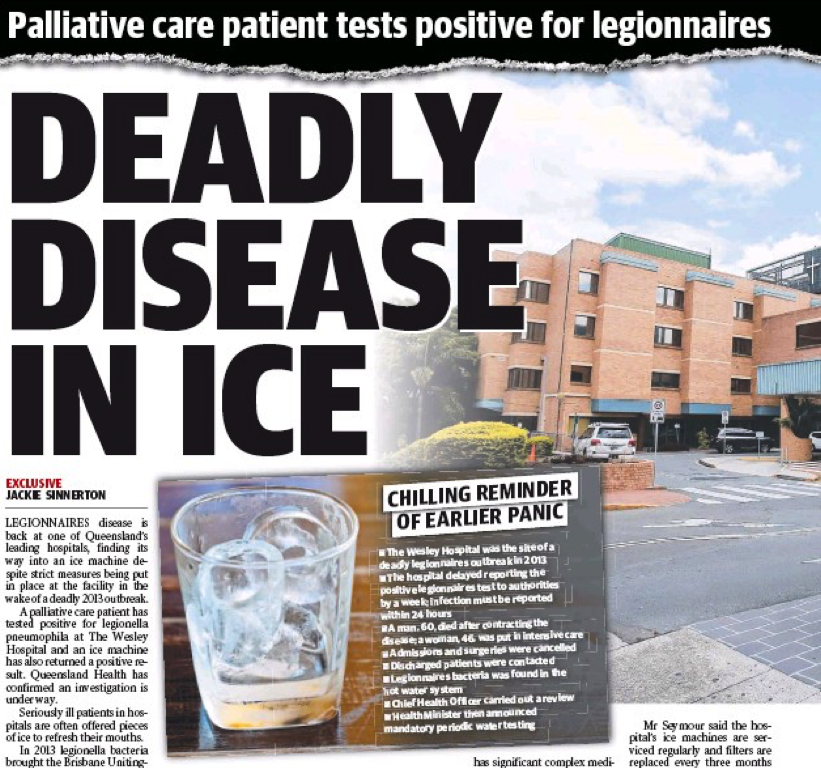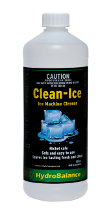A brief rundown of how Legionnaires’ disease can be spread through ice machines.
“A palliative care patient has tested positive for legionella pneumophila at The Wesley Hospital and an ice machine has also returned a positive result. Queensland Health has confirmed an investigation is under way.”
Source: The Courier-Mail
The long story
The recent discovery of an ice machine as the possible cause of a Legionnaires’ disease case at Wesley Hospital in Brisbane has many asking how Legionella bacteria can survive in such cold temperatures.

Source: The Courier-Mail
Legionella is a naturally occurring bacterium and can be found in low concentrations in soil and water. In manmade structures and warm environments (35-46 degrees), the bacterium thrives and can multiply to levels dangerous to humans.
When the bacterium becomes airborne, carried in water particles, it can be inhaled into the lungs, causing Legionnaires’ disease, a highly virulent form of pneumonia.
Stout & Yu, leading researchers in the field of Legionella research, have found that while the bacteria will not grow in cold conditions, it can survive freezing. If the bacterium is present in the water system used by the ice machine, it can be encased in the ice and released as the ice thaws.
Just as a building’s water pipes placed too close to sources of heat can lead to Legionella growth, ice dispensers contain compressors that can also warm the machine’s incoming water lines, allowing Legionella bacteria to thrive if the systems are not properly tested and treated.

Source: The Courier-Mail
The use of chlorine is a common treatment to prevent Legionella growth in water systems. Charcoal filters used to remove chlorine from the cold water line to make it more palatable for drinking can, however, also leave that water susceptible to Legionella contamination.
People with compromised immune systems are particularly at risk of contracting Legionnaires’ disease, a severe form of pneumonia that can prove deadly given the patients’ already existing health problems.
Severely ill patients are often offered ice to suck on to rehydrate and moisten their mouths, which leads to aspiration (the breathing in of the water particles), and infection where those water particles are contaminated with Legionella.
The risk of Legionella contamination in ice machines is well documented. South Australia had several cases of Legionella related to ice machines ten years ago and it has also been documented overseas.
While most hospitals and facilities have measures of testing and prevention in place, ice and water dispensers should be included in any risk assessment for Legionella in all health care facilities.
The recently published Australian “Guidelines for the Control of Legionella in the operation and maintenance of water distribution systems in health and aged care facilities” recommends all water systems in a health or aged care facility be assessed and controls put in place to minimise patients’ risk of exposure to this highly preventable, but often deadly disease.
HydroChem have long recognised this risk and has specifically developed products and maintenance programs to manage this risk associated with cooling and ice machines.
Contact us to find out how we can help.
The short story
1) The ice dispenser’s compressor can heat the piping inside the machine and warm the cold water supplied. This supports Legionella growth.
2) The charcoal filter on the cold water line removes the chlorine in the water therefore removing any residual to disinfect.
3) The bacteria can multiply.
4) The water becomes ice with the bacteria present (alive but not multiplying).
5) Patients in hospital, suck on the ice, which leads to aspiration (breathing in of the water droplets). This is a very direct route & therefore presents a very high risk for patients. When the patient’s immune system is suppressed the Legionella can quickly hide and mimic some of the remaining immune cells in the patient’s immune system to proliferate. Hence the patient has very little ability to fight the infection.
6) Ice and water dispensers should be included in any risk assessment for Legionella in all health care facilities.

Clean-Ice Ice machine cleaner
For a cleaner ice machine, Clean-Ice is specially designed to remove scale build-ups which can lead to bacterial contamination of ice. Suitable for use on all ice machines including those with nickel drums and aluminium or galvanised parts.
Fast acting, non-foaming and odourless, Clean-Ice can also be used for hot water heaters, vending machines, humidifiers and water cooled condensers.
